Departures July 30, 2017
Posted by stinawp in Uncategorized.add a comment
I only have 13 days left, and it really feels like the field season is coming to a close. My field assistant left Saturday morning, and the three students who’ve been working on their undergraduate thesis projects are leaving tomorrow. After that, the only researchers here will be me and the graduate student studying iguanas, and I don’t think we’re expecting any tourists. I thought the rain had left to give us our typical dry spell, but it’s come back with a vengeance. I hope it will at least pack down the mud near the wetland. Maybe it’ll even cut down on the mosquitoes. Here’s hoping!
Visits to the boardwalk July 27, 2017
Posted by stinawp in Uncategorized.add a comment
July 27, 2017
Although a large part of Palo Verde is wetland, I don’t spend much time looking at it, simply because it’s difficult to find caterpillars there when it’s actually wet. Which is a shame, since it’s probably the most obvious beauty of the park:

It’s also a great place to see lots of birds. One is the northern jacana, which is a goofy-looking wading bird that lives on top of the aquatic plants. A couple of days ago, someone told me that they’d seen baby jacanas near the boardwalk that goes into the wetland, so my field assistant and I took a quick break in our work to look for them. We wound up seeing a different group of two adults and three babies:

(Sorry, not the best photo. To find all five, start with the brown and yellow adult in the center. There are two brown and white chicks to the left, and another to the right. The darker brown bird to the right of that chick is the bent-over second adult.)
This grouping is actually rather odd, since male jacanas are the ones who take care of the chicks. Either two father/chick groups were hanging out together, or another adult was hanging out with one father/chick group. Unfortunately, male and female jacanas look very similar, so I have no idea what was going on.
Then this afternoon, I went out to retrieve my dropped head lamp and made another stop at the boardwalk. I saw a single jacana and chick in another spot, along with an anhinga, a bare-throated tiger heron, and a bunch of black-crowned night herons collecting sticks for nests.
Guest post, delayed July 25, 2017
Posted by newsthatstaysnews in Uncategorized.add a comment
Mini-lechuzas! July 23, 2017
Posted by stinawp in Uncategorized.add a comment
July 20, 2017
There are two general words for ‘owl’ in Spanish: búho and lechuza. As best as I can work out, búhos generally have ear tufts (think of a horned owl) while lechuzas generally don’t (think of a barn owl). At any rate, we saw two little owls of the lechuza variety today:
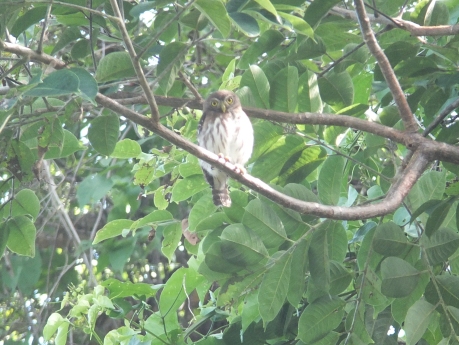


They turn out to have the disproportionately long English name of “ferruginous pygmy owl” and the slightly shorter Costa Rican common name of mochuelo. But since they’re the only pygmy owls at Palo Verde, I’ll probably just keep calling them mini-lechuzas. 🙂
Mérida, part 3 July 20, 2017
Posted by stinawp in Uncategorized.add a comment
I found my most interesting souvenir at a little convenience store shop in the Mérida airport. It’s a Spanish book of Mayan legends for kids, with pictures. That means it’s right at my reading level. Oddly, given the audience, most of the stories seem to be of the ‘star-crossed lovers’ variety, and the illustrations of human hearts (some of them were very star-crossed lovers) are all disturbingly lifelike.
But one of the stories, “Maquech”, is really interesting, because it explains yet another mystery for me. In the story, a princess is betrothed to a neighboring king. She happily accepts the betrothal, since the king’s a good and respected man, at least until she falls instantly in love with a warrior bringing war trophies to her father’s palace. Appropriately for this situation, the warrior’s main attractions seem to be that he’s young and handsome. He reciprocates, they meet in secret, they are found out, and the warrior is sentenced to be sacrificed. The princess begs her father for the warrior’s life, and he agrees, as long as she marries her betrothed. There’s also a second catch: the king has the warrior transformed into a large flightless beetle (called a maquech in Mayan) before giving him to the princess. She outfits the beetle in gold and jewels, including a gold chain so that they can never be separated. (No one seems to have asked the warrior whether he would have preferred death to spending the rest of his life as an insect accessory.)
The mystery the story solves is this:
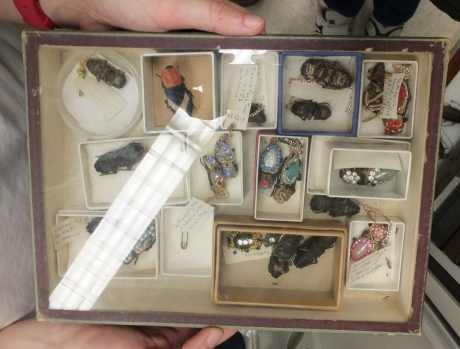
When I got a behind-the-scenes tour of the Smithsonian National Museum of Natural History a few years ago, there were drawers of these jewel-encrusted beetles. I was told that the beetles had been confiscated from people coming into the US from Mexico, but no one could tell me why people had been wearing live, decorated beetles. Now I know.
Larrocha, Sventlana. 2015. Leyendas Mayas. Editorial Dante: Mérida, México. 80 pages.
Mérida, part 2 July 16, 2017
Posted by stinawp in Uncategorized.add a comment
On Wednesday, the third day of the conference, I played hooky in the afternoon and went to the Gran Museo del Mundo Maya–the Great Museum of the Mayan World. The size of the building certainly lives up to the name:
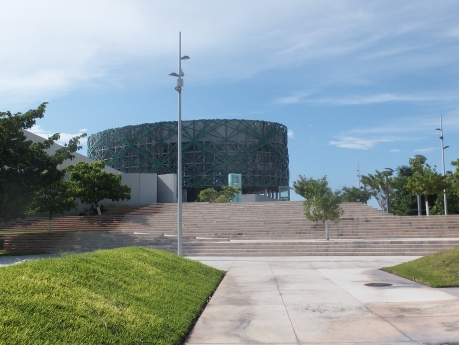
If you wanted to be pessimistic, you could say that the museum is organized around three catastrophes: the asteroid that crashed into Yucatan 65 million years ago, the collapse of the Classical Maya, and the Spanish conquest. The first exhibition hall has lots of items related to the asteroid, including an animated movie of the impact that’s actually called “Armageddon”. They didn’t really mention the fact that some dinosaurs survived and that they could be pooping on your windshield at this very moment. This struck me as since they went to some pains to point out that the Maya are still very much alive, despite their abandonment of their large cities in the 800s and the invasion of the Spanish in the 1500s.
It turns out that some people don’t like the term “collapse of the Maya” for what happened in the 800s. On the one hand, this strikes me as a bit silly—I want to go to Italy and ask whether people object to “the fall of Rome” as a description of what happened in the 400s. On the other, I think it’s much more obvious to your average First World resident that Rome continued to exist than the Mayans did. There also seem to be at least a few people who think that the abandonment of the cities was a successfully response to a changing environment, rather than a collapse. These people don’t particularly like Jared Diamond, either.
Regardless of the term, the Spanish conquest seems to have had more negative consequences, including some that continued (and are probably continuing) well into the future. One of these was the Caste War of Yucatan, which was a 50+ year war in the Yucatan between the Mexican federal government and the Mayans, who were trying to establish and maintain an independent state. One of the more memorable pieces in that exhibit was a bust of one of the Mayan generals—it was a facial reconstruction based on his skull, which had been placed in a now-defunct Yucatanean museum as a war trophy in the 1870s.
Despite all this, Maya languages and traditions still seem to be quite widespread—a lot of the exhibit signs were in Mayan, in addition to Spanish and sometimes English, and the first exhibits about the Maya were about contemporary Mayans. Those displays had a lot of crafts, including some traditional embroidery patterns:
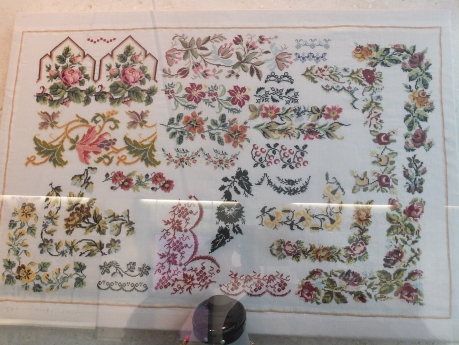
Mérida, part 1 July 14, 2017
Posted by stinawp in Uncategorized.add a comment
July 14, 2017
I started writing this in Mérida’s airport, and finished it in Houston’s. To quickly cover the basics: The conference was interesting, I gave a pretty good presentation, I had fun, etc. I have also doubled my number of foreign countries, although I don’t know how much I can extrapolate about Mexico in general from Mérida in particular.
The first thing I noticed about Mérida was that it doesn’t have four-to-six-inch ankle-breaker rain gutters the way San José and Palo Verde do. This area is relatively dry for the tropics, and either it doesn’t get torrential downpours as frequently as Palo Verde does, or people are okay with the streets flooding. Given the general upkeep of the city, and the fact that the entire area is incredibly flat (the second thing I noticed), I suspect it’s the former.
Something that took me a bit longer to notice was the sense of being in a large country again. While Costa Rica isn’t totally homogeneous, it’s a lot smaller and more centralized than either the United States or Mexico. Of the three, Mexico seems to emphasize regional identities the most. On learning it was my first time here, a taxi driver told me “welcome to Mexico, welcome to Mérida, and a double welcome to Yucatán*”. Similarly, almost all the food, art, and other cultural elements in Mérida were specifically identified, usually as Yucatean, sometimes as Mayan, rarely as an import from another region. When a dance company performed a series of traditional dances, almost every dance was identified with a particular state, like Veracruz or Oaxaca.
Incidentally, since Mexico has 31 states and is officially known as the Estados Unidos Mexicanos (United States of Mexico), it turns out that my current answer for where I’m from, “los Estados Unidos,” is theoretically ambiguous, although probably not to anyone who’s listening to me speak Spanish. Oh well, it’s still more informative than saying I’m an American.
* Yucatan is the name of both the state Mérida is in and the entire peninsula. I was never quite sure which was meant.
Exercise for an inattentive reader July 13, 2017
Posted by newsthatstaysnews in Uncategorized.add a comment
Guest post!
Hopefully, I’ll have a few more stories to tell in a bit, but for now, I came.
I saw.

I got hungry*.
I chilled.
* not actual research station food. actual research station food is, in fact, even tastier than shown here.
Big snake, little snake July 9, 2017
Posted by stinawp in Uncategorized.add a comment
July 9, 2017
I’m sitting in an airport on my way to Merida, Mexico for the Association for Tropical Biology and Conservation conference, so I have some time to kill. I also had to get up at 4:15 in the morning to make my flight out of Costa Rica, so I’m a little tired. The last few days have been weird, since it’s almost been like getting ready to leave for good. Less packing, but more making sure that my assistant has everything she needs to hold down the fort for the week.
Anyway, the snakes. Yesterday, we saw a big boa constrictor in the road:

There’s not much in the photo for scale, but it was at least 5 feet long. On the other end of the spectrum, here’s the slender blindsnake we found in the lab the day before:
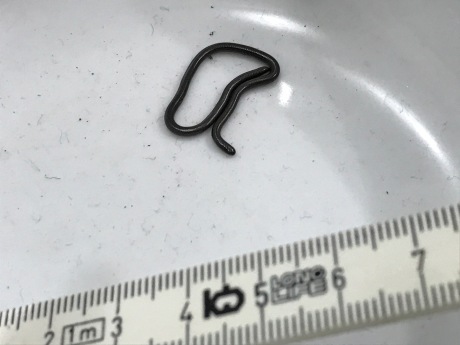
That was maybe three inches long. When we looked at it under a low-magnification microscope, the scales almost looked like they’d been woven together, like the outer wrapping of a round shoelace.
Old and new mysteries July 6, 2017
Posted by stinawp in Uncategorized.add a comment
July 6, 2017
A mystery from my 2013 field season just got solved. I finally identified this bird, which I had such trouble with that I was wondering if Palo Verde might be outside its normal range:
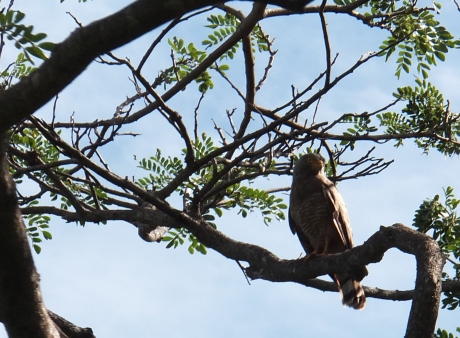
It turns out it’s a roadside hawk (Rupornis magnirostris) and is perfectly common here. The problem is that the bird book shows the head as being a light ash-gray rather than the slate color here. After someone told me the color varied and a quick image search, it looks like there are ash-colored birds, slate-colored birds, and chocolate-colored birds that all have the same color pattern and are all this species. I don’t understand why the bird book doesn’t say anything about the variation, but at least that’s one mystery solved.
The new mystery is how my caterpillars are escaping from their Ziploc bags. This is happening more frequently than I’d like, especially with caterpillars that are almost ready to pupate. Sometimes there’s a hole in the bag, sometimes it seems like the bag didn’t get completely zipped, but most of the time the bags seem well-sealed. My field assistant and I are making jokes about ninja caterpillars, but we have no idea what’s going on.

